Born on the 25th of May 1887 into a working-class family, the young Francesco appeared a child like any other as he played with his peers, however inside something extraordinary was about to happen…
The third-born, from a young age Francesco suffered from poor health and would have been regarded as a “delicate” child. At the age of five years, in the local parish Church of Sant’ Anna, the young Francesco experienced his first vision when the Sacred Heart appeared to him. In his naivety Francesco understood this happened to everybody.
Prayer was an integral part of the daily routine in the Forgione family home and, growing up, Francesco often liked to spend time alone in prayer. At the age of ten years, Franceso announced to his parents that he wanted to follow a religious path in life. The regular visits made by the young capuchin friar, Fra Camillo, to Pietrelcina were instrumental in the decision of Francesco to join the Capuchin Order and become just like Fra Camillo, “a monk with a beard.”
Recalling his days in Pietrelcina, Padre Pio often commented that “you would never find a ten lire piece, but we never lacked anything necessary.” If Francesco were to enter the religious life, he would have to be educated first. His need for private tuition would cost money and without hesitation his father and brother Michele travelled to America to earn money. Padre Pio often commented “My father crossed the ocean twice to give me the possibility to become a friar."
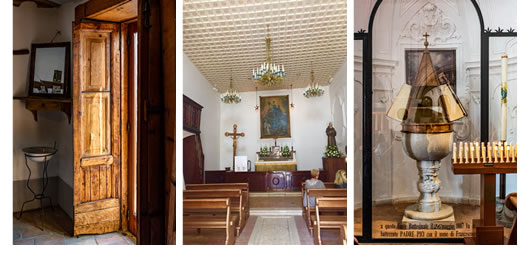
Church of Sant' Anna, Pietrelcina
Francesco received private tuition and excelled as a student. At the age of 11 years he made his First Holy Communion and Confirmation at the Church of Sant ’Anna. On the 6th of January Francesco left home for Morcone, to begin his novitiate. His mother, broken-hearted, reassured her son saying, “St. Francis has called you and you must follow.”
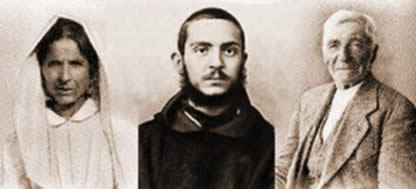
On the 22nd of January 1903 Francesco took the Capuchin habit and the name “Br. Pio” – his journey as a Capuchin friar had begun. Life in the friary of Morcone was most austere however Padre Pio immersed himself in his daily routine of prayer, chores, discipline and often fasting. The following years were marred with illness, the solution of which was always to return to his native town of Pietrelcina where the air was clear.
In those days the minimum age for ordination to the priesthood was 24 years. In the January of 1910 Padre Pio fell so ill that he thought he might die. In a letter to his Spiritual Director, Fr. Benedetto, Padre Pio appealed for a special dispensation to be ordained earlier than usual. The dispensation was granted and on the 10th of August 1910, in the cathedral in Benevento, Padre Pio was ordained. Four days later Padre Pio would celebrate his first Solemn Mass in the parish Church of Santa Maria degli Angeli. In his homily, his confessor Padre Agostino, commented that Padre Pio, due to his poor health would not make a good preacher but would make a good confessor.
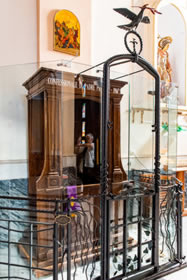

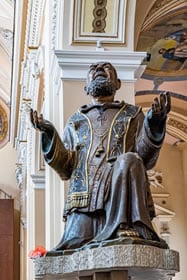
On the month following his ordination, September 1910, whilst praying beneath an Elm Tree at the family farm in Piana Romana, Jesus and Mary would appear to him and give him the wounds of the stigmata. In a state of embarrassment, Padre Pio went to the parish priest, Don Panullo, recounting to him what had happened him in Piana Romana and asked Don Panullo to pray for him, that the marks of the wounds would disappear – he said he had no problem suffering but did not want those around him to be aware of his suffering. They prayed together and the prayers were answered.
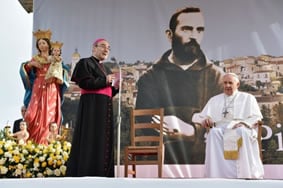
Visit of the Holy Father, Pope Francis to Piana Romana � 17th March 2018
Such was his embarrassment that it was not until one year after the event that Padre Pio wrote to his spiritual director. In the letter he wrote: “Something happened to me which I can neither explain nor understand. In the centre of the palms of my hands a red patch appeared, about the size of a centesimo and was accompanied by an acute pain. The pain was much more acute in the left hand and still persists. I also feel some pain in the soles of my feet.’ This phenomenon has been going on for almost a year, yet recently there has been a brief period of time in which it has not occurred. Please do not be upset that I have not mentioned it to you before. The reason is that I had to overcome a cursed embarrassment to tell you about it. If you only knew the real effort, I had to make to tell you about it! I would have told you many things, but I was unable to express myself.”
The poor health of Padre Pio would continue in the years that would follow and his daily routine in Pietrelcina consisted of assisting the parish priest in his ministries in the mornings and in the afternoon, at the family farm in Piana Roman, he would spend time in prayer.
In letters to his Spiritual Directors, Padre Pio later spoke of regular attacks he experienced from the Devil in the evening time in the “Tower” where he slept opposite the family home in Pietrelcina.
In 1911, much to the satisfaction of Fr. Benedetto, Padre Pio returned to monastery life when he was sent to friary at Venafro. It was here that fellow friars began to witness the supernatural phenomena and ecstasies which were often followed by apparitions of Jesus, Mary, his Guardian Angel and St. Francis of Assisi. Padre Pio's health would deteriorate yet again and he would return to Pietrelcina where he would remain until 1916.
 Convent of Sant’ Anna, FoggiaIn February 1916 Padre Pio, accompanied by Padre Agostino, travelled to Foggia to assist Raffaelina Cerase, a noble woman who was dying of breast cancer. Each day Padre Pio would visit Raffaelina and celebrate Mass in her home until her death on March 25th. At this point the decision was made that Padre Pio should remain at the capuchin convent of Sant ‘Anna in an attempt to return to monastery life. The attacks from the devil continued for Padre Pio during his time in Foggia, which became evident to his fellow friars.
Convent of Sant’ Anna, FoggiaIn February 1916 Padre Pio, accompanied by Padre Agostino, travelled to Foggia to assist Raffaelina Cerase, a noble woman who was dying of breast cancer. Each day Padre Pio would visit Raffaelina and celebrate Mass in her home until her death on March 25th. At this point the decision was made that Padre Pio should remain at the capuchin convent of Sant ‘Anna in an attempt to return to monastery life. The attacks from the devil continued for Padre Pio during his time in Foggia, which became evident to his fellow friars.
In the July of 1916, the suffocating heat of Foggia caused great suffering for Padre Pio and the superior at the convent in San Giovanni Rotondo, Padre Paolino, invited him to come to the hill-top town to breath some of the fresh air. Padre Pio arrived in San Giovanni Rotondo for the first time on the 28th of July and felt great relief. After a short period he would have to return to Foggia, as agreed. Upon his return Padre Pio would write immediately to the Provincial and ask for permission to transfer permanently to San Giovanni Rotondo. His request was granted and in the following September Padre Pio would return to San Giovanni Rotondo and within a short space of time began to make an impact, forming a prayer group of local women who would come together on a weekly basis to spend time in prayer.
For the following years Padre Pio carried out his ministries from the old Church of Our Lady of Grace, taught in the seminary and offered guidance to his growing number of spiritual children.

On August 5th, 1918, Padre Pio experienced the Transverberation of the Heart. In a letter to his Spiritual Director, he described the event:
"I was hearing the confessions of the boys, when a Celestial Being holding a steel sword with a sharp flaming point, hurled it into my soul with all his might. All happened in the split of a second, everything inside me was lashed with fire and steel. From that moment on I feel an open wound which causes me to suffer continual agony."
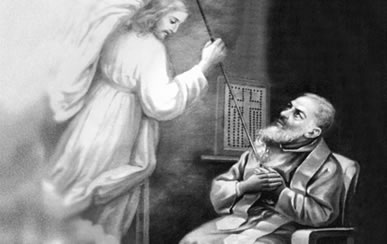
The morning of the 20th of September of the following month seemed a day like any other day in the convent of Our Lady of Grace when after the celebration of Mass, Padre Pio went into the choir loft to spend time in prayer. Whilst praying in front of the Crucifix he received the Wounds of Christ.
As news broke of the stigmatised friar from the Gargano and of the extraordinary events taking place daily in San Giovanni Rotondo people began arriving to the town. Opinions of people differed greatly with some debating the authenticity of the stigmata.
The Holy See sent many doctors, to investigate the wounds and it was concluded that the wounds were not as a result of tuberculosis as had been previously thought, the wounds could not be explained by human science and it was certain that they were not self-inflicted.
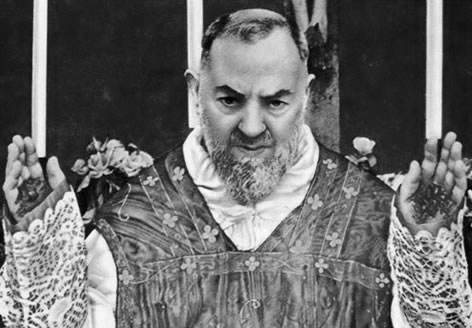
Uncomfortable by the attention the capuchin friar was generating, the Holy See suggested the transfer of Padre Pio would be the solution to quell the "celebrity status" of this capuchin friar. In the August of 1923 notification arrives from the Holy See that Padre Pio will be transferred to Ancona. The local people hear of this proposed move and threaten to take action. Padre Pio at all times remained obedient to his superiors however on advice of the local police, the order for the transfer was revoked. Padre Pio would remain in his beloved San Giovanni Rotondo.
In the December of 1928, Padre Pio’s mother arrived in San Giovanni Rotondo and stayed in the house of Mary Pyle. After a short illness, Mamma Peppa would pass away, leaving her son broken-hearted.
Life at the friary continued for Padre Pio. As time progressed it was clear that the Lord had granted him great gifts. People would travel from the world over to attend Padre Pio’s Mass and confess to the humble friar.
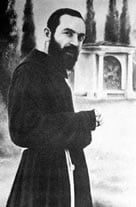
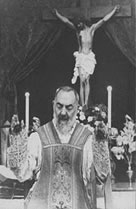
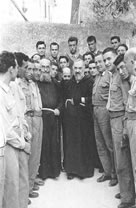
On the feast of Corpus Christi in 1931, the Holy See ordered that Padre Pio would have to cease his priestly duties with the exception of the celebration of Mass which could take place only in the private chapel of the friary. For Padre Pio this was a period of great suffering. By 1933 Pope Pius XI ordered the Holy See to reverse the decision and slowly Padre Pio returned to the celebration of Mass and hearing of confessions.
In 1925 Padre Pio had built a small hospital in San Giovanni Rotondo which was destroyed by an earthquake that hit the town in 1938. The town was in need of a hospital and so Padre Pio decided to build a hospital, a “cathedral of charity” where science and prayer would unite in order to heal the suffering of the sick.

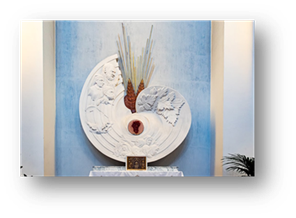
On the 9th of January 1940 Padre Pio called a meeting in his cell and formed a committee that would be responsible for the founding of the hospital. Padre Pio declared "This evening my earthly work has begun. I bless you and all those that will contribute to the work which will become bigger and even more beautiful. I myself want to make the first offering." and from his pocket Padre Pio took a small gold coin that he received that very day from one of the faithful.
The foundation stone for the hospital was laid in May 1947 and Padre Pio’s dream was realised when the hospital was inaugurated on the 5th of May 1956. The hospital was to be known as “Casa Sollievo della Sofferenza” (Home for Relief of the Suffering) which Padre Pio called "a creature of Providence". Over sixty years since its inauguration the hospital is now one of the most important hospitals in southern Italy and a very important research centre.
Another deeply spiritual and charitable work which Padre Pio begun was the founding of the Prayer Groups which have now spread throughout the world.
Padre Pio lived his life as a true servant of St. Francis of Assisi, spending many hours administering the Sacrament of Reconciliation and in prayerful meditation. Described by Pope Francis as a ‘perfect example of an untiring, welcoming and patient confessor’, Padre Pio soon continued to draw many pilgrims from Italy and abroad.
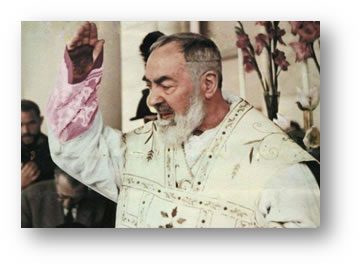
Padre Pio had the ability to read hearts, the ability to speak foreign languages, the gift of bilocation - he once heard the confession of a young girl in St. Peter’s Basilica even though he had never left San Giovanni Rotondo. He had the gift of healing, prophecy and miracles and had the ability to perform his duties living on a frugal diet with little sleep.
In the early 1960’s Padre Pio’s health began to deteriorate and in early 1968 he was forced to use a wheelchair. On the day of the 22nd of September 1968 Padre Pio celebrated Mass – a final gift to his Prayer Groups who had assembled from all parts of the world.
As the day ended the humble friar raised his hand, as always, to bless the crowd. As the light went out the crowd dispersed. It seemed a night like any other but instead was the last night of the life of the humble friar. Shortly after renewing his vows and receiving the Sacrament of the Sick he gave up his soul and flew peacefully to Heaven, with his rosary beads in his hand, with the words ‘Jesus and Mary’ on his lips, the signs of the Stigmata no longer visible. His life on earth was over; his earthly sufferings endured had ended.
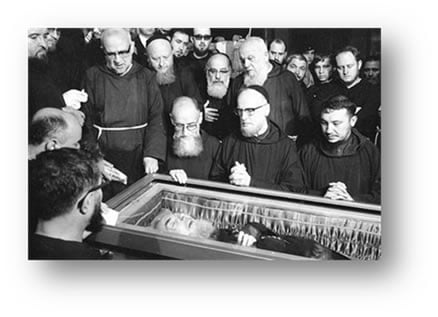
His body was placed on the 26th of September in the tomb of the Church of Santa Maria delle Grazie and remained there for almost forty years.
In May 1999 in St. Peter’s Square, Padre Pio was declared blessed by Pope John Paul II who had a great affection for the capuchin friar. With an estimated 300,000 people in attendance on the 16th of June 2002 Pope John Paul II canonised Padre Pio.
As a result of the growing number of devotees arriving in San Giovanni Rotondo from all over the world, it was decided to build a bigger church to comfortably accommodate the faithful. Work began in 1994 and after ten years under construction, the church was inaugurated in 2004 and dedicated to St. Pio of Pietrelcina.

In February 2008, almost forty years after his death, the remains of Padre Pio were exhumed. After the celebration of Mass on the 24th of April of that year, the remains of Padre Pio were placed in a crystal, marble and silver sepulchre and went on display for veneration by the faithful in the old tomb of the Church of Santa Maria delle Grazie.
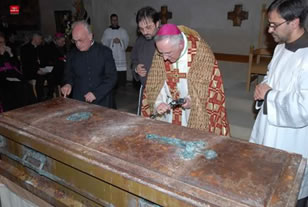

In February 2008, almost forty years after his death, the remains of Padre Pio were exhumed. After the celebration of Mass on the 24th of April of that year, the remains of Padre Pio were placed in a crystal, marble and silver sepulchre and went on display for veneration by the faithful in the old tomb of the Church of Santa Maria delle Grazie.

During the Extraordinary Jubilee Year of Mercy in 2016, Pope Francis requested the remains of two great capuchins, St. Pio of Pietrelcina and St. Leopold Mandic, be brought to St. Peter�s Basilica for veneration by the faithful.
Two years later, on the occasion of the 100th anniversary of the stigmata and the 50th anniversary of the death of St. Pio, the Holy Father made his own personal pilgrimage in the footsteps of St. Pio with a visit to the town of Pietrelcina, before continuing onto San Giovanni Rotondo. In San Giovanni Rotondo he visited the child oncology unit of the hospital, “Casa Sollievo della Sofferenza”, before the celebration of Mass in the open Church of St. Pio of Pietrelcina. During the Angelus Blessing the following day in St. Peter’s Square the Holy Father thanked the people of San Giovanni Rotondo for their warm welcome and said that he would hold always in his heart the staff and patients of the Casa Sollievo della Sofferenza.
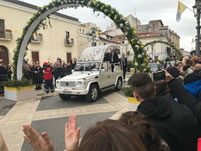

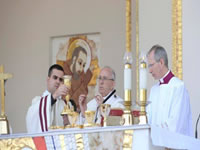
Visit of the Holy Father, Pope Francis to Piana Romana � 17th March 2018
Today millions of pilgrims continue to arrive in San Giovanni Rotondo to pray at the crypt of the Saint. The once remote capuchin friary has now become the heart of the sanctuary which is now the second most visited shrine in the world.
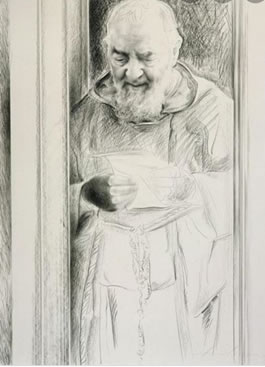
St. Pio of Pietrelcina
25th May 1887 � 23rd September 1968



